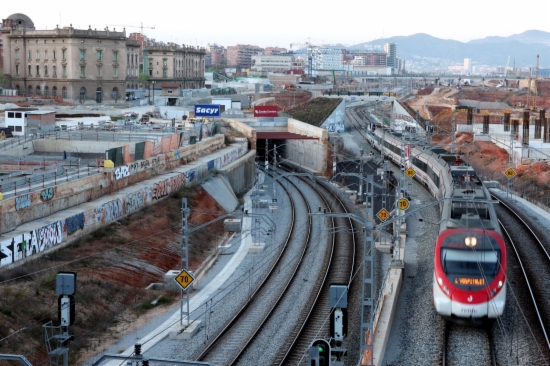Barcelona's new High-Speed Train station has its budget reduced from €800 to €650 million
The Spanish Transport Ministry and Barcelona’s City Council signed an agreement to unblock the construction work of La Sagrera train station, which was on hold due to the current financial crisis. This project is the main urban planning initiative Barcelona has been trying to develop since the Olympics. It involves building a huge inter-modal station, combining high-speed trains, short- and medium-distance trains, underground trains and buses. In addition, many retail, office and housing buildings would be built on top of the station and nearby. On top of this, a 4.5 kilometre-long park would be created, covering the rail yard and connecting several neighbourhoods that are now separated by the tracks. In early 2013, the project was at risk since the Spanish Government had not guaranteed its funds, despite the fact that construction work started years ago.

Barcelona (ACN).- The Spanish Transport Ministry and Barcelona’s City Council signed this week an agreement to unblock the construction work of La Sagrera train station, a strategic project for Catalonia’s economy and Barcelona’s town planning. The project is the main urban planning initiative Barcelona has been trying to develop since the Olympics. It involves building a huge inter-modal station, combining high-speed trains, short- and medium-distance trains, four metro lines and buses. It will be used by 100 million passengers per year and it will become the main transport centre in Barcelona, being the main train station in the city and the base for High-Speed Trains going to France. It will be connected to Sants Station – which currently is Barcelona’s main station – via an urban tunnel which has already been built. However, the Sagrera project goes beyond a mere transport centre. A 4.5 kilometre-long park would be created, covering the huge rail yard and connecting several neighbourhoods that are now separated by the tracks. In addition, many retail, office and housing buildings will be built on top of the station and on the sides of the station and the park, creating a new neighbourhood. Some of these buildings are included in La Sagrera’s €650 million budget, but many others were to be developed separately. One of the buildings not included was a skyscraper designed by the American architect Frank Gehry, known as ‘The Bride’.
Gehry’s skyscraper was the first project linked to La Sagrera to be put on hold a few years ago and nowadays its final construction seems in fact quite unfeasible in the current economic context. However, construction work on La Sagrera Station and the platform to cover the huge rail yard continued until 2012. Then, the whole transport and urban planning project was put on hold due to the financial crisis and the situation of public budgets. In fact, for a few months it seemed that the entire project could even be at risk despite the fact that construction work started years ago. In early 2013 the Spanish Government had not guaranteed the funds to continue the construction, which activated alarms in Barcelona. A negotiation process started to unblock the construction by reducing the project’s budget and reshaping it. With the agreement signed this week, construction work will start again, although the station will probably not be finished by 2016, as initially expected. The Mayor of Barcelona, Xavier Trias, stated that is “an ambitious project, but solid and economically-viable”. He also emphasised that “it was at risk of being totally paralysed” because of the budget situation.
Private investors will have to bring in €300 million
The Spanish Transport Minister, Ana Pastor, and Trias signed on Wednesday a new protocol, which is reducing the budget of La Sagrera’s project from the initial €800 million to €650 million. The project’s main change is in the distribution of the funding sources. With the burst of the Spanish real estate bubble, the station can no longer be built thanks to the €400 million that were expected to be cashed in as added value with the new buildings. Instead, now only €30 million are expected. Furthermore, the previous project did not include private money and now this will cover almost half of the costs. Private investors are supposed to bring between €300 million and €350 million to the project by renting the 6,000 square-metre shopping mall that will be created in the station and on top of it. They will have to bring in all the money at the start of the concession and in exchange they will have commercial exploitation of the retail space for 60 years. In addition, the Spanish Government will reduce its contribution, dropping from €400 to €255 million.
Costs have been reduced mainly on three aspects. Most of the aesthetic elements will be eliminated. The station’s cover and main hall will be significantly modified. The number of high-speed railways tracks will be reduced from 5 to 4. However, the new project has still some questions unanswered, such as what will happen with the 4.5-kilometre platform covering the rail yard and the park to be build on top of it. In addition, it is not clear which buildings will exactly be developed in the end.